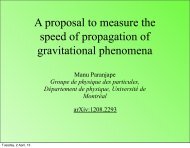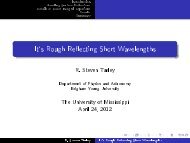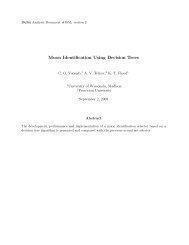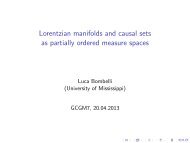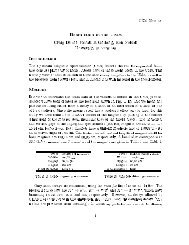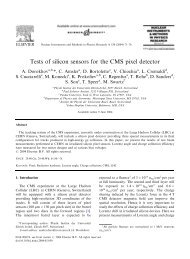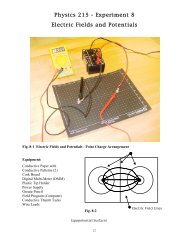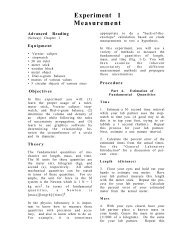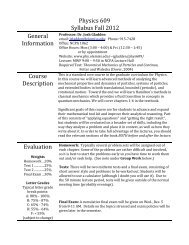Energy Loss of Particles in Matte
Energy Loss of Particles in Matte
Energy Loss of Particles in Matte
You also want an ePaper? Increase the reach of your titles
YUMPU automatically turns print PDFs into web optimized ePapers that Google loves.
The <strong>Energy</strong> <strong>Loss</strong> <strong>of</strong> <strong>Particles</strong> <strong>in</strong> <strong>Matte</strong>r<br />
I. Attenuation Length <strong>of</strong> a Photon Beam <strong>in</strong> a th<strong>in</strong> Absorber<br />
A beam <strong>of</strong> photons will be attenuated <strong>in</strong> the forward direction <strong>in</strong> a material <strong>of</strong> thickness x based on simple<br />
scatter<strong>in</strong>g or absorption processes. The l<strong>in</strong>ear attenuation coefficient µ scales with material density ρ, and<br />
the mass attenuation coefficient µ/ ρ is <strong>of</strong>ten reported.<br />
! dI<br />
I =!("N A<br />
)# !dx =!µ!dx!!<br />
A<br />
!!!!!!!!!!!!!!I = I 0<br />
!e ! µX !!!!!!<br />
albedo or<br />
back scatter<br />
I 0<br />
Secondary<br />
α,β,γ<br />
processes<br />
I<br />
Part <strong>of</strong> the beam may be absorbed <strong>in</strong> the material or scattered out <strong>of</strong> the beam. Sometimes the beam may<br />
create secondary scatter<strong>in</strong>g processes and new forms <strong>of</strong> α, β ,γ radiation may emerge from the absorber.<br />
II. <strong>Energy</strong> loss by Heavy Charged Particle (Stopp<strong>in</strong>g Power)<br />
Heavy charged particles ( charge z) loose energy pr<strong>in</strong>cipally be ionization processes <strong>in</strong> materials. The<br />
ionization cross section is denoted by σ ionization and measured <strong>in</strong> barnes (10 -24 cm 2 ) The Bethe Bloch<br />
atoms<br />
!/cm 3<br />
formula gives the energy dependence <strong>of</strong> the energy loss. The electron density n e<br />
= !N A<br />
A<br />
Alpha particles ( z=2) will loose four times as much energy <strong>in</strong> matter as protons (z=1).<br />
! dE<br />
dx = 4" z 2 % e 2<br />
mc 2 # 2 &<br />
' 4"$ 0<br />
x<br />
2<br />
( %<br />
)<br />
*<br />
n e<br />
+ln 2mc2 # 2 (<br />
&<br />
'<br />
I(1 ! # 2 ))<br />
* !# 2 Bethe ! Bloch Formula<br />
" Z<br />
http://pdg.lbl.gov/2009/AtomicNuclearProperties/<strong>in</strong>dex.html
III. Range<br />
We can determ<strong>in</strong>e the mean range <strong>of</strong> <strong>of</strong> heavy charged particles <strong>of</strong> k<strong>in</strong>etic energy T by <strong>in</strong>tegration <strong>of</strong> the<br />
stopp<strong>in</strong>g power -dE/dx.<br />
R(T ) =<br />
T<br />
'<br />
0<br />
! dE $<br />
"<br />
#<br />
dx %<br />
&<br />
(1<br />
dE<br />
IV. Range <strong>of</strong> Alpha <strong>Particles</strong> <strong>in</strong> Air<br />
The range <strong>of</strong> alpha particles <strong>in</strong> air can be parameterized as<br />
R = 0.4 E Eα < 4MeV<br />
R= 1.24E – 2.62 4 < Eα
e<br />
e’<br />
e<br />
e’<br />
e ion<br />
hf<br />
Ionization<br />
Radiation<br />
The radiation yield is the fraction <strong>of</strong> the total dE/dx produc<strong>in</strong>g radiative photons.<br />
(! dE dx) Y =!!<br />
rad<br />
(! dE dx) + ! dE<br />
rad dx<br />
( ) ion<br />
! 6 " 10!4 ZT<br />
!!#!!Radiation!Yield <strong>of</strong> stopped electron<br />
1+ 6 " 10 !4 ZT<br />
The radiation yield <strong>of</strong> an absorber can be a dangerous source <strong>of</strong> secondary radiation! The number <strong>of</strong><br />
gamma rays produced falls as 1/Eγ but higher energy photons at the end <strong>of</strong> the spectrum will escape the<br />
absorber. The radiation flows <strong>in</strong> the direction <strong>of</strong> the <strong>in</strong>cident electron beam with a Δθ∼1/ E γ distribution .<br />
dN !<br />
dE<br />
Infrared<br />
photons<br />
E = Ε’ + Eγ<br />
Eγ<br />
E γ max= Ε ε<br />
E<br />
E’<br />
E γ<br />
IVa. X-rays production by electrons<br />
X-rays are copiously produced by stopp<strong>in</strong>g electrons <strong>in</strong> a heavy metal target <strong>of</strong> high-Z material. The<br />
generated x-ray spectra is composed <strong>of</strong> a (a) cont<strong>in</strong>uous bremsstrahlung portion and (b) an x-ray l<strong>in</strong>e<br />
spectra described by the Bohr model. Zeff takes <strong>in</strong> to account the effective shield<strong>in</strong>g <strong>of</strong> the nucleus<br />
by <strong>in</strong>ner oribital electrons and other sp<strong>in</strong>-orbit and sp<strong>in</strong>-sp<strong>in</strong> effects.<br />
" d! %<br />
#<br />
$<br />
dk &<br />
'<br />
Brem<br />
"<br />
~!<br />
#<br />
$<br />
Z 2<br />
T i<br />
%<br />
&<br />
' ! 1 k !ln " 4T i %<br />
#<br />
$<br />
k &<br />
' !!!!!!!!!!!!!!!!(a)<br />
E L(<br />
!!Z eff 2 ) 13.6eV !(! 1<br />
n 1<br />
2 * 1<br />
n 2<br />
2 )!!!!!!!!!!!!(b)<br />
electron<br />
beam<br />
x-rays<br />
Metal<br />
target<br />
In a typical electron x-ray tube, electrons are accelerated to the target by Vacc = 10’s <strong>of</strong> KVolts <strong>of</strong><br />
potential. A 100KV x-ray tube will produce at best 10 KeV x-rays !
The bremsstrahlung is caused by the de-acceleration <strong>of</strong> the electron <strong>in</strong> the metal. The x-ray l<strong>in</strong>es are from<br />
the fill<strong>in</strong>g <strong>of</strong> <strong>in</strong>ner core electrons that have been displaced.<br />
K,L,M x-rays are produced <strong>in</strong> materials when <strong>in</strong>ner atomic electrons are dislodged or ionized. Follow<strong>in</strong>g<br />
the Bohr model, Mosely predicted x-rays would follow the pattern:<br />
E K!<br />
!!(Z " 1) 2 # 13.6eV !(! 1 1 2 " 1 2 2 )!<br />
E K$<br />
!!(Z " 6) 2 # 13.6eV !(! 1 1 2 " 1 3 2 )!<br />
n=5<br />
n=4<br />
E L!<br />
!!(Z " 6) 2 # 13.6eV !(! 1 2 2 " 1 3 2 )!<br />
E L$<br />
!!(Z " 6) 2 # 13.6eV !(! 1 2 2 " 1 4 2 )!<br />
etc.<br />
K α K β K γ<br />
Computed Tomography<br />
The attenuation <strong>of</strong> X-rays pass<strong>in</strong>g through an object can be used for imag<strong>in</strong>g – computed tomography. For<br />
a monoenergetic x-ray beam and a variable density absorber we can <strong>in</strong>tegrate over the l<strong>in</strong>e <strong>of</strong> sight <strong>of</strong> the<br />
beam and obta<strong>in</strong> the image after many measurements are made. A typical scenario <strong>of</strong> a CT scan is shown<br />
below.<br />
I x,y<br />
= I 0<br />
!e ! " µ(x,y)! s source<br />
!!!!!<br />
ln(I 0<br />
/ I x,y<br />
)!=!"<br />
µ(x, y)ds<br />
!1<br />
µ(x, y) =!! #<br />
$ ln(I 0<br />
/ I x,y<br />
)!%<br />
& '!x-ray!image<br />
n=3<br />
n=2<br />
n=1<br />
L α L β L γ<br />
M α M β M γ<br />
detector
Questions to Answer:<br />
1) Estimate the k<strong>in</strong>etic energy at which collisional and radiative stopp<strong>in</strong>g power are equal for electrons <strong>in</strong><br />
(a) Be , (b) Cu, (c) Pb.<br />
2) Estimate the fraction <strong>of</strong> the energy <strong>of</strong> a 2 MeV beta ray that is converted <strong>in</strong> to bremsstrahlung when the<br />
particle is absorbed <strong>in</strong> lead.<br />
3) Use Table 6.1 to estimate the range <strong>in</strong> cm <strong>in</strong> air for electrons <strong>of</strong> (a) 50keV, (b) 830 keV, (c) 100 MeV<br />
4) Use Table 5.3 to determ<strong>in</strong>e the m<strong>in</strong>imum energy that a proton must have to penetrate 30cm <strong>of</strong> tissue, the<br />
approximate thickness <strong>of</strong> the human body.<br />
5) Us<strong>in</strong>g table 5.3 for protons mass stopp<strong>in</strong>g power <strong>of</strong> water, estimate the stopp<strong>in</strong>g power <strong>of</strong> Lucite<br />
(ρ=1.19g/cc) for a 35 MeV proton.<br />
6) How far will 10 MeV alphas penetrate <strong>in</strong> air (ρ=1.24 x 10 -3 g/cc, STP)<br />
7) Estimate the energy <strong>of</strong> the Kα X-ray <strong>in</strong> Pb.



